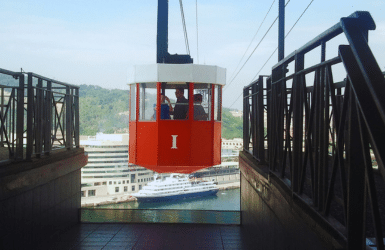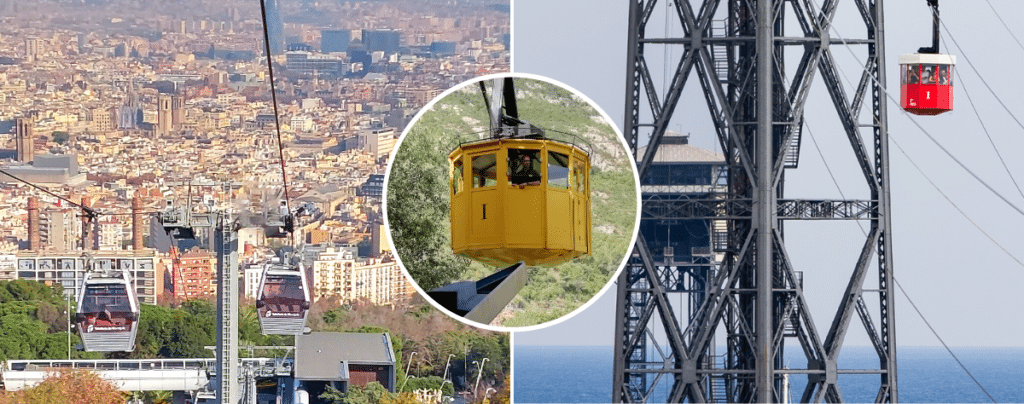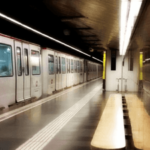
Discovering all the Barcelona Cable Cars
GUIDE TO THE AERIAL TRAMS AND GONDOLAS IN BARCELONA
Barcelona doesn’t lack of fun transportation means. There’s cable cars, funiculars, tramways, rack trains… Not many cities have such an interesting offer! But today we’ll be focusing on those that allow you to see Barcelona from the sky. I know that there’s a bit of confusion about the exact terms that are used for them, as sometimes “cable car” is also used for terrestrial transportation (such as those in San Francisco). But for the scope of this post we’ll be discussing these two different types of cable cars:
- Aerial Trams. Those that use one or two stationary ropes for support, and one more for propulsion, and go up and down the same ropes biderectionnally. You’ll also hear them referred as ropeways, aerial tramways, sky trams, aerial cable ways, teleferiques and seilbahns. There’s only one cabin per propulsion rope. In Spanish we call them “transbordador aereo” or for short “aereo”, or we use the generic word “teleferico”. In Catalan, it’s “transbordador aeri”, “aeri” or “telefèric”.
- Gondola lifts. They consist on a single rope on a loop in continuous motion, which allows for a number of cabins at the same time. In Spanish and Catalan we know them as “telecabina”, or we also use the generic word teleférico/telefèric.
How many cable cars are in Barcelona?
1
Transbordador Aeri del Port (the Barcelona Cable Car)

The Port Cable of Barcelona was founded in 1929 for the 2nd World Fair of Barcelona. It connects the Barcelona beaches with the Miramar vantage point, where the restaurant of the World Fair used to be (now the building has been transformed into a fancy 5 star hotel), with an intermediate tower in between (St. Jaume) - but you can't get out there. It's a vintage aerial tramway with two red cabins that travel over the port vell marina, offering spectacular views over the sailboats, the sailboatts, the W hotel, Columbus monument, the bottom of La Rambla and the rest of the city beyond,.
Because there’s only two cabins going every 15 minutes, the lines are slow. If you take it from the Barceloneta area you’ll be taking an elevator to the actual Cable Car departing level. At the Montjuic station there’s one flight of steps between the cable car station and the street level (so people on wheelchairs will have to ride back without exiting the cabin). During the ride passengers are standing, and the firsts to get in get the best spots by the windows.
By the way, did you know at the Wax Museum of Barcelona they have an immersive ride inspired in the Port Cable Car that takes you all over the city without moving from one museum room? It’s really cool, and it’s scared-of-heights friendly!
Opening hours: Every day (except December 25), from 10.30AM to 7PM. During the Summer season it stays open until 8PM, and October through February it only opens 11AM to 5.30PM.
How to get there:
- St. Sebastia Tower: Buses V15 and V19, both connecting with the subway L4 line (Barceloneta Station). Alternatively you can walk 15 minutes from there.
- Montjuic Station: Red route of the Bus Turistic hop-on hop-off bus. Bus 150 from Plaça Espanya (metro L1 and L3), you’ll be going through the entire line and after the end stop at the Montjuic Castle, it’s 2 mores stops on the way down. Alternatively you can take the Funicular de Montjuic from Paral·lel Station (subway L2 and L3), then walk 15 minutes.
Food options:
- St. Sebastia Tower: On the Torre de Sant Sebastia there’s a fine dining seafood restaurant, Torre de Alta Mar, but the access is different from that of the cable car. Find here more restaurants in the Barceloneta area.
- Montjuic-Miramar station. The Montjuic station incorporates a restaurant and cafe with city views, and it’s just 3 minutes walk from the famous Terraza Martinez, a restaurant with great tapas and paella. Find here more restaurants in Montjuic Hill.
Things to do:
- Near St. Sebastià tower: swim at the Barcelona beaches or explore the Barceloneta District.
- Near Montjuic-Miramar station: Visit the Mossen Cinto Llobera cacti garden or use it as a starting point to visit the Hill of Montjuic.
2
Teleferic de Montjuic (the Barcelona Gondola Lift)
Because there’s many cabins and the gondola motion doesn’t stop (it just slows down at the stations so you can easily hop on and off the cabins), the lines move relatively fast. Often you’ll be able to get an entire cabin for your own party. And since you are seating during the ride and the cabins are transparent, everyone gets to enjoy the views. All the stations are adapted for wheelchairs, and 2 cabins are adapted, too.
Opening hours: It opens every day from 10AM to 6PM. October and March through May it stays open until 7PM, and June-September until 9PM. The only exceptions are December 25 and January 1 and 6, when it closes at 2.30PM.
How to get there:
- Lower station: Funicular of Montjuic (from Paral·lel metro station on L2 and L3). Buses 55 (from Urquinaona and Plaça Catalunya) and 150 (from Plaça Espanya). Red route of the Bus Turistic hop-on hop-off bus.
- Castell de Montjuic Station: Bus 150 from Plaça Espanya (metro L1 and L3).
Food options:
- Lower station: Almost across the street from the cable car station there’s the fancy El Xalet, and just a bit further you’ll find the bar of the municipal pools, both with excepcional city views. More restaurants in Montjuic.
- Montjuic Castle station. There’s a cafe inside the Castle (but you’ll have to pay the admission to access it).
- Mirador de l’Alcalde stop. There’s a small cafe at the vantage point.
Things to do:
- Near the lower station: swim at the municipal pool (Summer season only), stroll around the Mossen Costa Llobera tulip garden (best during Springtime), visit the Miro Foundation and the rest of the Hill of Montjuic.
- Near the Castle station: Visit the Castle of Montjuic. Take an easy hike to the Caseta del Migdia vantage point or walk to the Lighthouse (a bit more tricky path). Take the kids to the giant slides of the Joan Brossa gardens.
Can you do both Barcelona cable cars in one day?
Yes, you can easily go from the Port Cable Car to the Montjuic Cable car either on foot (it’s just 17 minutes walk), or by bus (Line 150, it’s way faster from Miramar to the bottom station of the Montjuic gondola than the other way around), or by Tourist Bus (from the bottom station of the Teleferic de Montjuic to Miramar only).
COMPARISON CHART OF THE CABLE CARS IN BARCELONA, SPAIN
| Aeri del Port | Montjuic Cable Car | |
|---|---|---|
| Tickets | ||
| Number of cabins | 2 | 55 |
| Cabin capacity | 19 people | 8 people |
| Seats | No | Yes |
| Incline | 151ft / 46m | 277.3ft / 84.55m |
| Max. Height | 331ft / 101m over sea level | 557.7ft / 170m over sea level |
| Lenght | 0.8mi / 1,3km | 2,467ft / 752m |
| Travel time | 7 minutes | 8 minutes |
| Frequency | Every 15 minutes | Non-stop |
| Wheelchair Friendly | No (only St. Sebastià tower) | Yes (two cabins) |
Other cable cars near Barcelona
3
Aeri de Montserrat
4
Teleferic de la Vall Fosca (Estany Gento)
The Vall Fosca is a scenic valley in the Pyrenees that makes part of the National Parc of Aiguestortes i Llac de St. Maurici. This vintage blue was built to help with the construction of the hydraulic power central of Sallent, and now it’s used to transport hikers and visitors. It takes 14 minutes to cover an incline of 1476.3ft / 450m, and from the top station start many mountain hikes, from easy family hikes to routes for experienced mountaineers such as the famous Carros de Foc.
Getting to the Vall Fosca isn’t easy, though: you’d rather plan to stay overnight in the area. By car it takes a bit over 3 hours, and getting there by public transportation isn’t easy either: you’ll first have to take the Alsina Graells to La Pobla de Segur, then from there a local bus to La Central de Capdella. By the way, be prepared to climb the 80 steps that lead to the cable car station from the road.
5
Gondola lifts in ski resorts
There’s many more gondola lifts in Catalonia, but most of them are linked to ski resorts.
- Telecabina Coma del Clot, in Vall de Nuria. This iconic valley of the Pyrenees can only be accessed either hiking from the village of Queralbs, or taking the rack train stopping in Queralbs and Ribes de Freser (this last one reacheable by train). The valley has a small lake, a sanctuary wher the Nuria Virgin Mary is worshipped, and a ski resort with easy to medium slopes, a hotel and several cafes and restaurants. And from there departs the gondola connecting with the Pic de l’Aliga mountain shelter, where you can either stay, eat or enjoy the views. Open all year around. Maximum height: 6960.6ft / 2121,6 m.
- Telecabina Alp 2500. Its 48 cabins connect two Catalan ski resorts: La Molina and La Masella, now reunited under one single forfait. At the top station there’s another mountain shelter, Niu de l’Aliga (I know, similar names but different shelters). Open all year around. Maximum height 8323.5ft / 2537m.
- Telecabina de Baqueira. Located in the Vall d’Aran valley, with ski resorts that attract Spanish royals and celebrities. Its 93 cabins give access to the Baqueira Beret ski station with stops at two different levels. Open all year around. Maximum height 5905.5ft / 1800m.
- Cable cars in Andorra. Andorra is a small independent country between France and Spain, 2.5 to 3 hours drive from Barcelona. And there you’ll find so many more cable cars! The most famous one is the Funicamp, the longest gondola lift in Europe, connecting the village of Encamp with the Grand Valira ski resort covering 3.7mi / 6km in 15 minutes. There’s also the Telecabina Tristaina (Ordino-Arcalis ski resort), another cable car connecting the Pal and the Arinsal ski resorts, another one taking you from the village of La Massana to the Pal ski resort, and there’s a project to build one more connecting the capital, Andorra la Vella with Pal via the Pic del Carroi mountain.
RESEARCHING FOR A TRIP IS TIME-CONSUMING…
Need more inspiration?
Our 100% FREE Barcelona Collection will give you everything you need to organize the trip of your lifetime to Barcelona.
BEST INSIDER TIPS FROM THE PROS!








